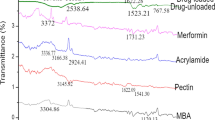Abstract
The release of enrofloxacin entrapped in polyvinyl alcohol (PVA) cryogel at pH 5.5 showed a first-order kinetic, releasing 69.7% of the antibiotic after 4.5 h at 37 °C. In order to slow down the fluoroquinolone release rate, high-methoxylated pectin was added into the cryogel (PVA–P). A film containing 1.0% (w/v) HM pectin and 5.0 μg/ml enrofloxacin released only 3.7% of the antibiotic after 4.5 h. Since the FTIR spectrum showed that most of the interactions between PVA–P matrix and enrofloxacin were due to polar groups (carboxylate and amine), a two-layer film system was designed to modulate the releasing rate of the drug. The top film equilibrated with 0.75 or 1.5 M NaCl release up to 41.9% and 89.0% of the enrofloxacin in 4 h, respectively. The release rate of enrofloxacin was found dependent on NaCl concentration in the upper gel layer. The two-layer cryogel system showed attractive features for transcutaneous antibiotic delivery.







Similar content being viewed by others
References
Kung, K., Riond, J.-L., Wolffram, S., & Wanner, M. (1993). Research in Veterinary Science, 54, 247–248.
Seedher, N., & Agarwal, P. (2009). Indian J Pharm sci, 71, 82–87.
Maurer, N., Wong, K. F., Hope, M. J., & Cullis, P. R. (1998). Biochimica et Biophysica Acta, 1374, 9–20.
Jiang, S., Liu, S., & Feng, W. (2011). Journal of the Mechanical Behavior of Biomedical Materials, 4, 1228–1233.
Hassan, C. M., & Peppas, N. A. (2000). Advances in Polymer Science, 153, 37–65.
Hassan, C.M., Stewart, J.E., & Peppas, N.A. (2000). European Journal of Pharmaceutics and Biopharmaceutics, 49, 161–165. (ex 8)
Zsivanovits, G., MacDougall, A. J., Smith, A. C., & Ring, S. G. (2004). Carbohydrate Research, 339, 1317–1322.
Prashantha, K. V. (2001). Bulletin of Material Science, 24, 535–538.
Yoo, M. K., Sung, Y. K., Lee, Y. M., & Cho, C. S. (2000). Polymer, 41, 5713–5719.
Hua, S., Ma, H., Li, X., Yang, H., & Wang, A. (2010). International Journal of Biological Macromolecules, 46, 517–523.
Coffin, D. R., Fishman, M. L., & Trung, V. Ly (1996). Journal of Applied Polymer Sciences, 61, 71–79.
Fishman, M. L., & Coffin, D. R. (1998). Carbohydrate Polymers, 35, 195–203.
Kaczmarek, H., Browska, A. D., & Vuković-Kwiatkowska, I. (2011). Journal of Applied Polymer Sciences, 122, 1936–1945.
Nesseem, D. I., & El-Houseny, S. S. (2011). Life Sciences, 89, 430–438.
Devi, V. K., Saisivam, S., María, G. R., & Deepti, P. U. (2003). Drug Development and Industrial Pharmacy, 29, 495–503.
Kenawy, E., El-Newehy, M. H., & Al-Deyab, S. (2010). J Saudi Chem Soc, 14, 237–240.
Lu, S., Ramirez, F., & Anseth, K. (1998). AICHE Journal, 44, 1689–1696.
Su, X., Kim, B.-S., Kim, S., Hammond, P., & Irvine, D. (2009). ACS Nano, 3, 3719–3729.
Acknowledgments
The present work was supported by the Consejo Nacional de Investigaciones Científicas y Técnicas (CONICET), Agencia Nacional de Promoción Científica y Técnica (ANPCyT) of Argentina and Proyecto API Gobierno de La Pampa-UNLPam. We want to thank Dr. Paul Dumas (SMIS beam line, Soleil Synchrotron Facility, France) for his kind support and expertise during the sample analysis. Also, thanks to Mr. Ignacio Pérez de Verti and Dr. Sergio G. Marchetti for the FTIR spectra.
Author information
Authors and Affiliations
Corresponding author
Additional information
Yanina N. Martinez and Lucrecia Piñuel contributed equally to the work.
Rights and permissions
About this article
Cite this article
Martinez, Y.N., Piñuel, L., Castro, G.R. et al. Polyvinyl Alcohol–Pectin Cryogel Films for Controlled Release of Enrofloxacin. Appl Biochem Biotechnol 167, 1421–1429 (2012). https://doi.org/10.1007/s12010-012-9554-6
Received:
Accepted:
Published:
Issue Date:
DOI: https://doi.org/10.1007/s12010-012-9554-6




